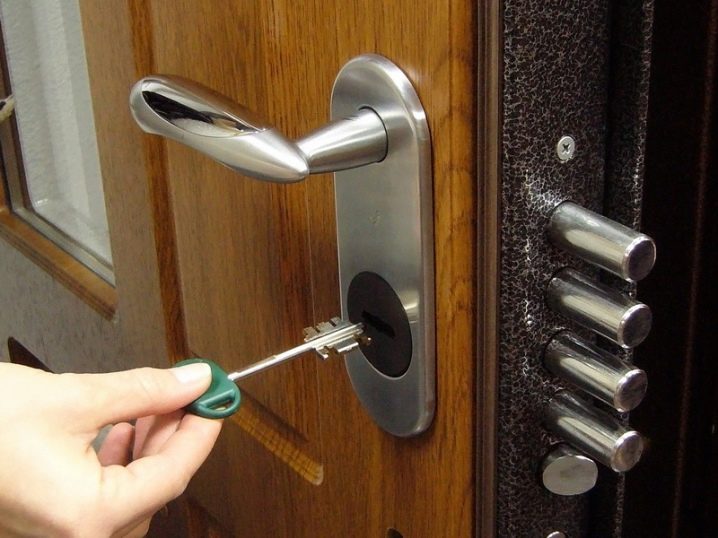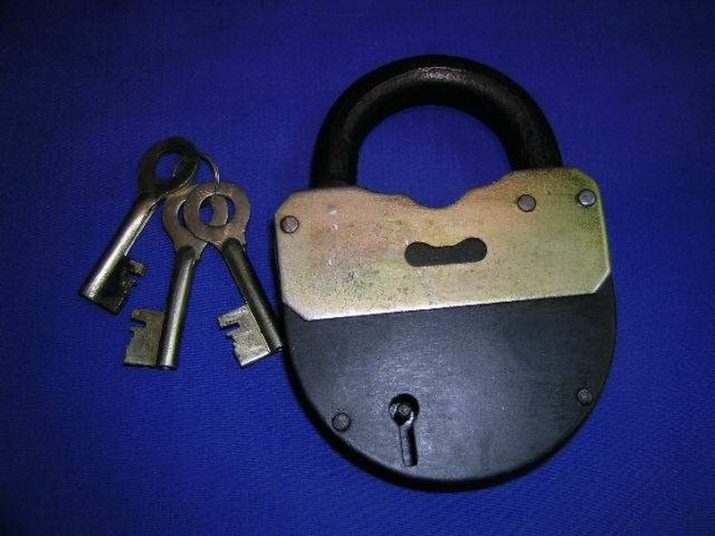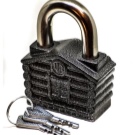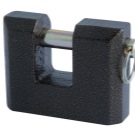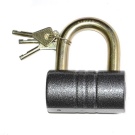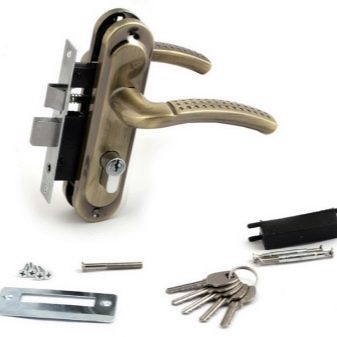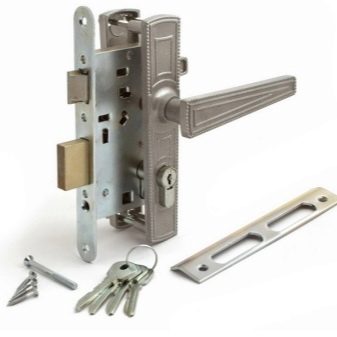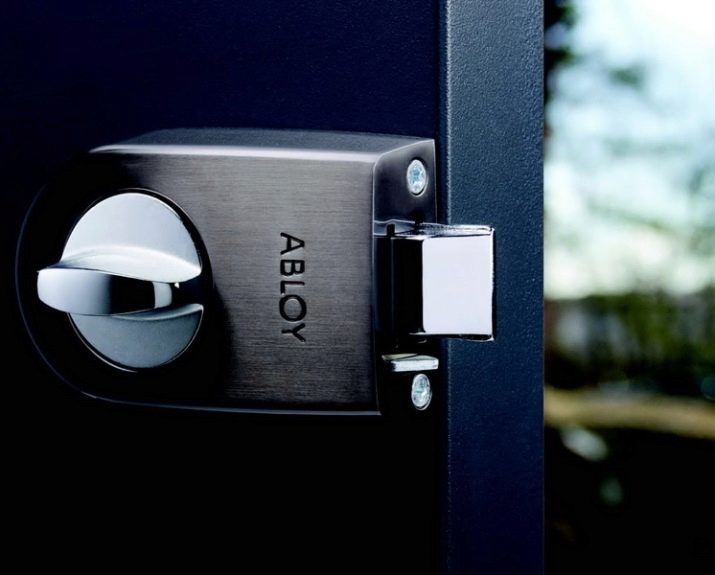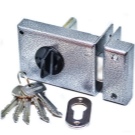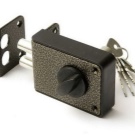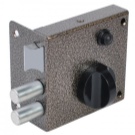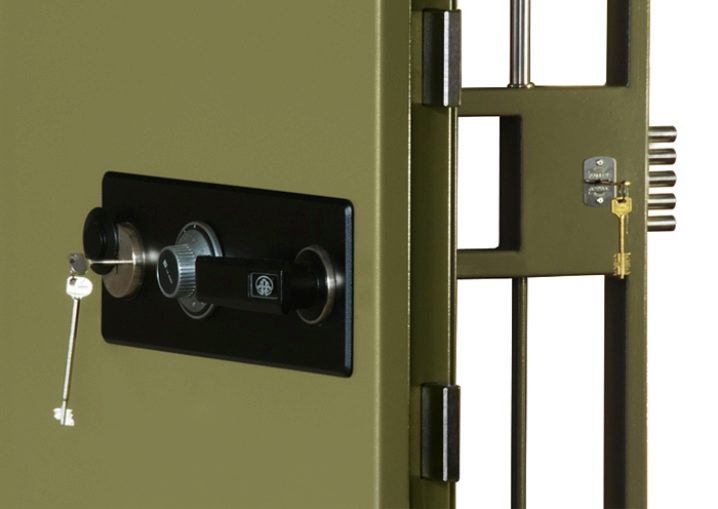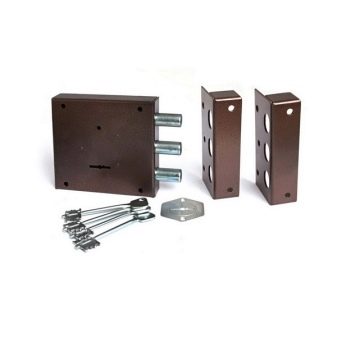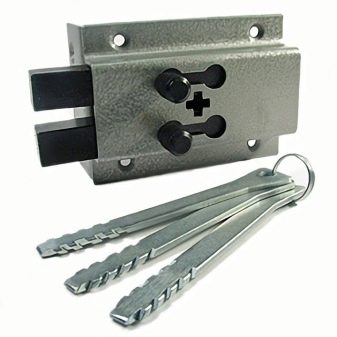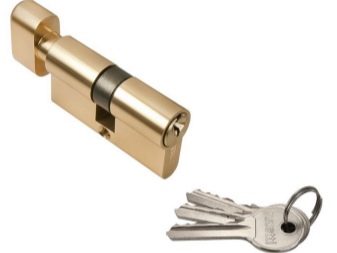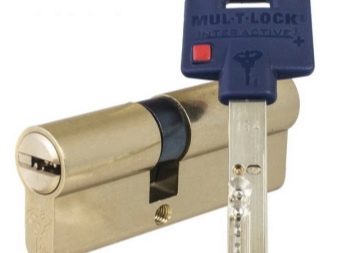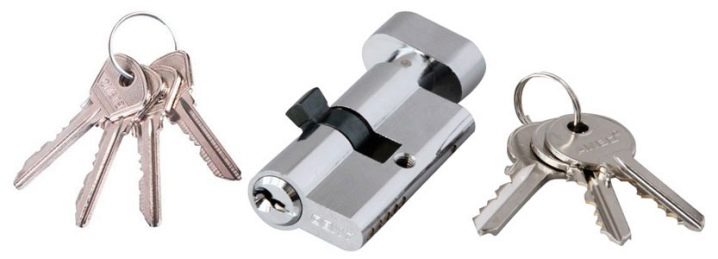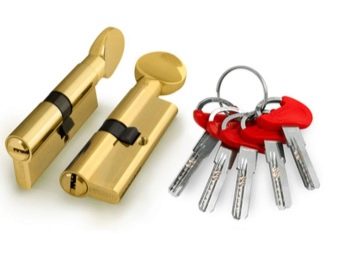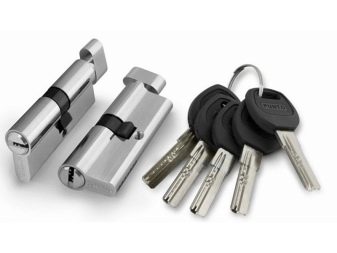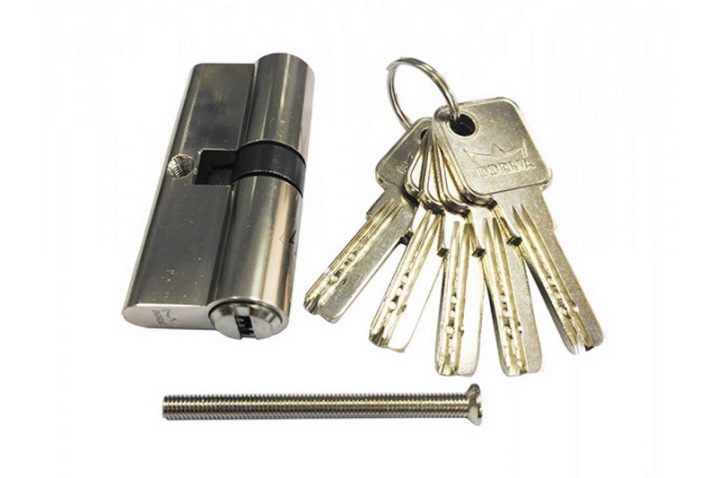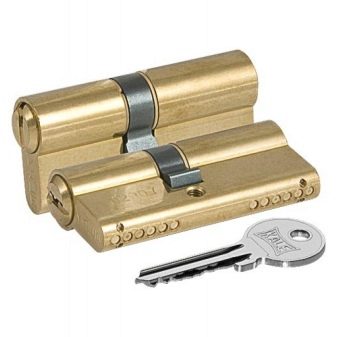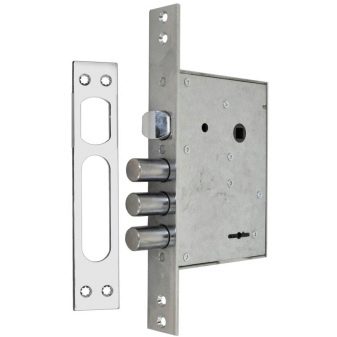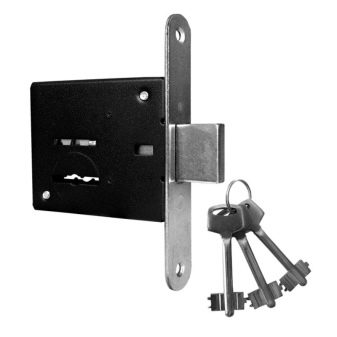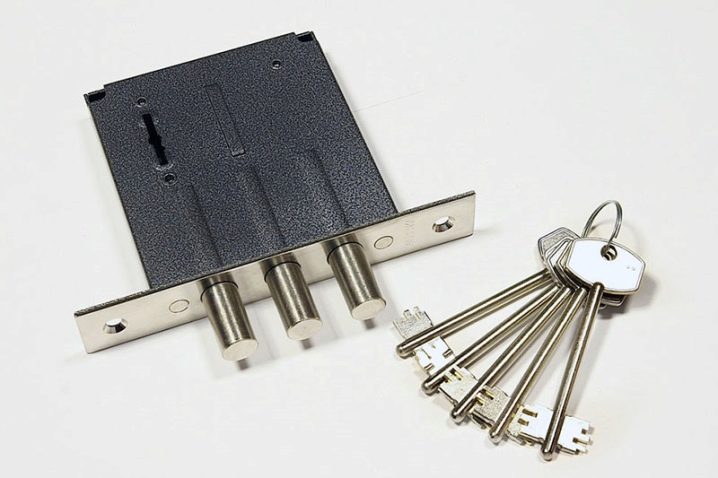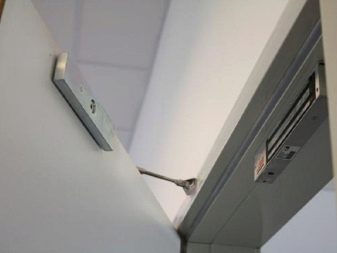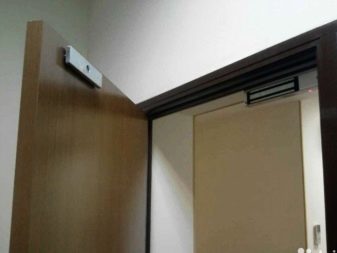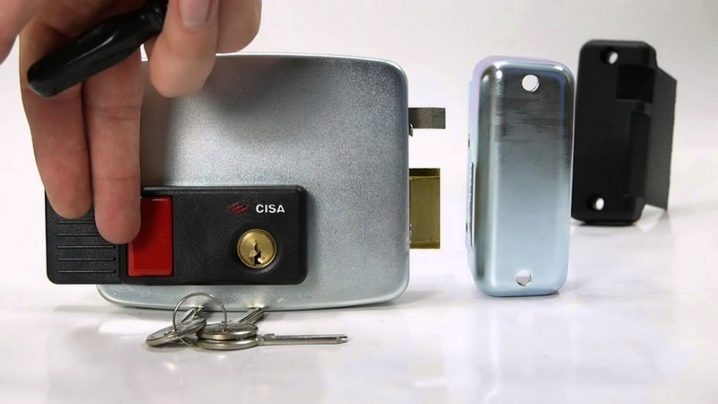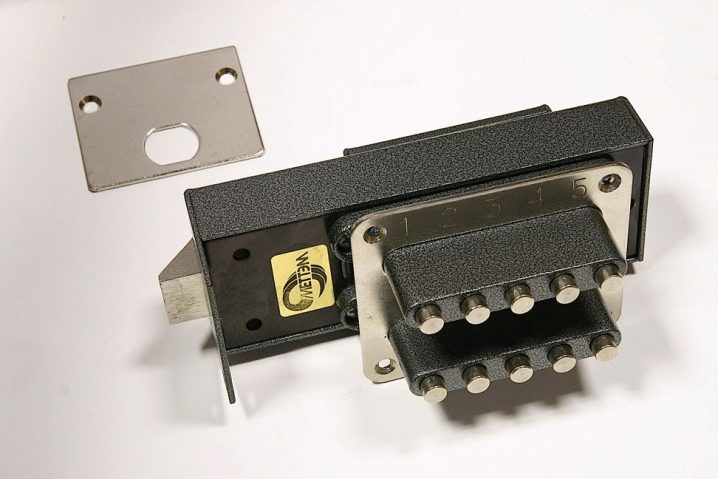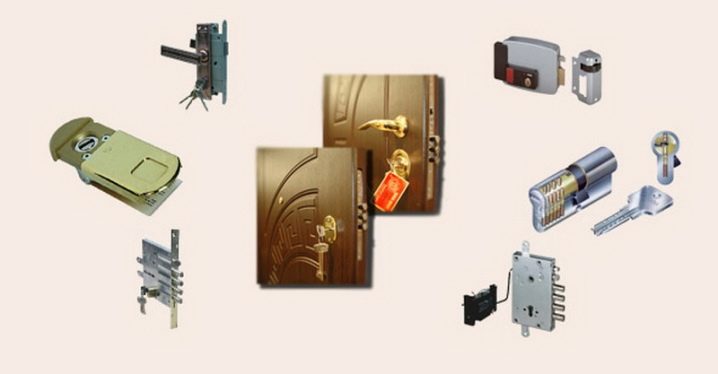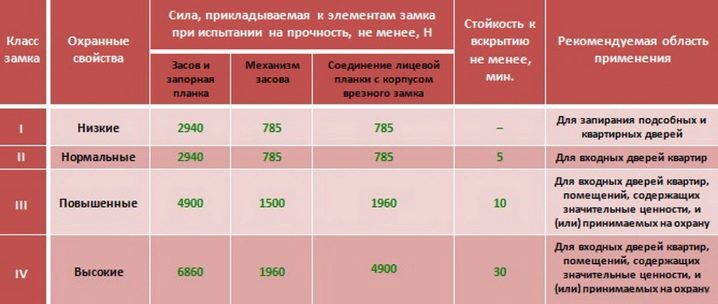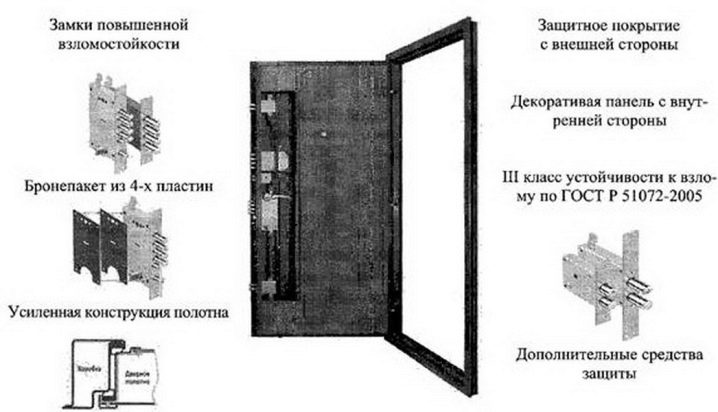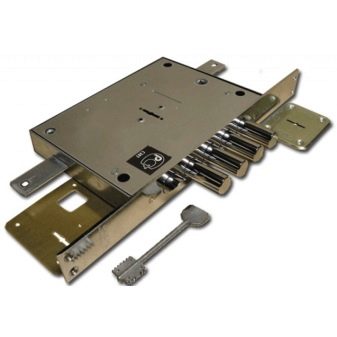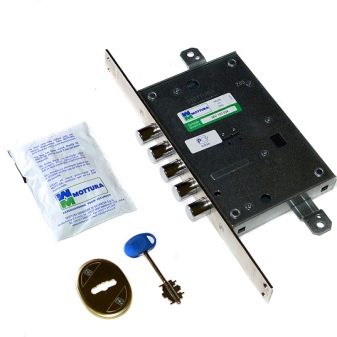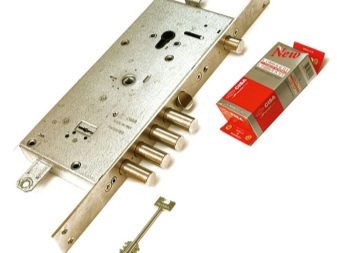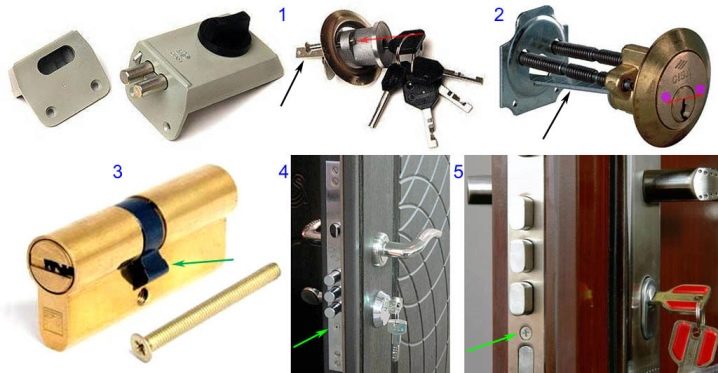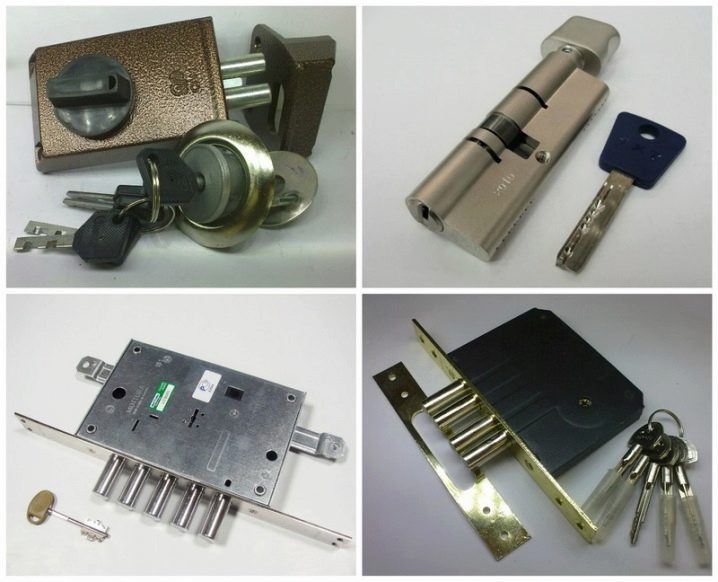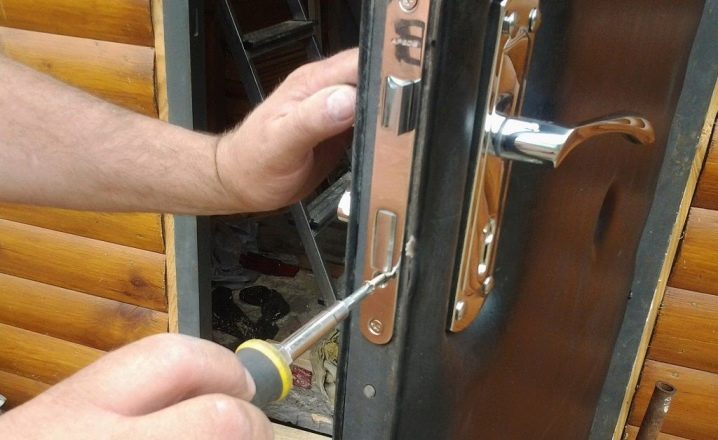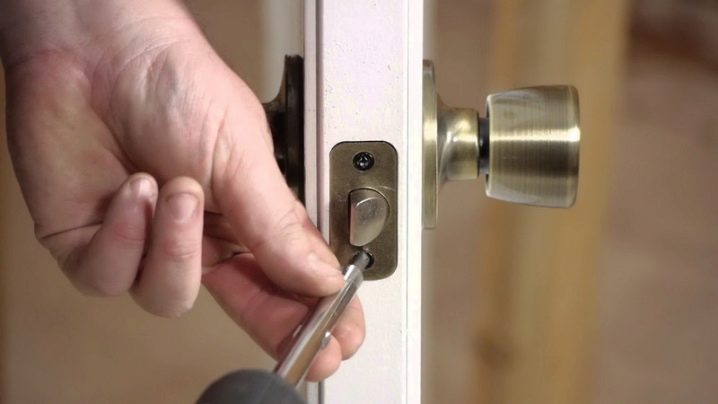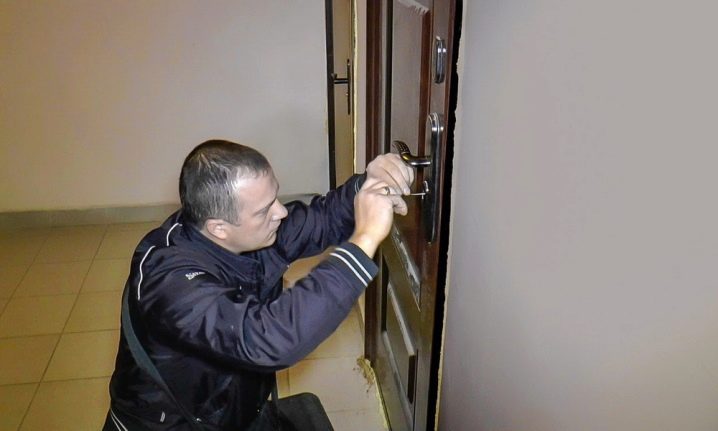Locks for metal doors: views, tips on installation and operation
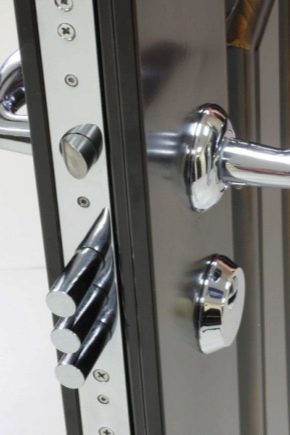
Locks for metal doors are represented on the market of door designs and accessories in a huge range. Therefore, the main thing with their purchase is a clear understanding of the principle of operation of each of the locking mechanisms, and the choice of the most optimal option.
Kinds
The classification of locks for metal doors is made according to several criteria, of which the method of installation is decisive. According to this criterion, padlocks, surface-mounted and mortise types are distinguished, the difference between them is not only in the installation technique and location, but also in the degree of protection, scope of use and the level of burglar-resistant products.
Hinged
Hinged models are locking devices that are hung on the outer surface of the door leaf with the help of special eyes welded or bolted to the door. This option is one of the weakest ways to protect the premises, it has a very simple design and a low degree of protection. The range of mounted models is quite diverse. The models differ in the type of construction, materials of manufacture, the size of the body and the bow, and the mechanism of secrecy. The simplest options are classic products with arcuate and T-shaped arms. Their use cannot provide high protection of the premises against penetration, and is rather of a warning nature. A bit more serious are semi-closed devices in which the fixing part of the handle is protected by the instrument case, as well as devices of a closed structure with a fully concealed handle and combination locks without keys. Hinged models are used on metal doors of garages, basements and storage rooms.
Mortice
Mortise models are the most popular option for locks and are installed inside door panels.The advantages of these devices is a higher, in comparison with padlocks, the level of protection and burglary resistance class. In addition, products are available in a wide range and are considered the most numerous group of locking devices for iron doors. The disadvantages of the mortise structures include too close arrangement of the working mechanism of products to the surface of the door leaf, because of which there is a possibility of cutting and sawing out such devices. However, these troubles can be avoided by equipping the door with additional protective plates that make it difficult, and sometimes even impossible, to access the lock mechanism. Another drawback of the mortise models is complicated installation, which involves the use of professional equipment and the presence of certain experience with the metal.
Overhead
Overhead designs, unlike mortise, are characterized by ease of installation and can be installed independently. The devices are fixed over the doors from the inside and are fixed with bolts. The advantages of the locks include the sufficient remoteness of the working mechanism from the outer surface of the door, which makes them difficult to saw,and also replacing the old product with a new one without compromising the appearance and integrity of the door. The disadvantages include the impossibility of mounting on door systems equipped with a secret porch, as well as ease of opening from the inside. The last moment is fraught with unhindered departure from the apartment of thieves who entered the dwelling through a window or through a balcony.
Functionally, overhead and mortise products are divided into locking and locking-locking. The first ones do not have a fale latch (in common people - “dogs”), and when closing they need to tightly press the door to the box with the help of physical effort. The second ones are equipped with a pull-tab and push handle, which makes them the most convenient to use. In addition, on the overhead models, there is often a chain, which also improves their usability.
However, a key criterion for the classification of locks is the type of locking mechanism. On this basis, the devices are divided into six types.
Bolts
Bolt locks are the simplest designs, equipped with slats with teeth and grooves, and the configuration of the grooves completely coincides with the shape of the grooves on a long key.The main difference when unlocking the bolt lock is the absence of the need to turn the key in the keyhole. To open such a device, it is enough to insert the key into the well and press it all the way. When this occurs, the compression of the spring and locking lath goes sideways. Bolt devices have low protective qualities and therefore belong to the lowest safety class. The scope of application of transom constructions involves their installation in rooms that do not contain special material values. Devices can be found on metal access doors, gates, wickets and in utility rooms.
Cylinder
Products of this type are divided into pin and disk. The discs were invented and introduced into production by the Finnish company Abloy, which is why they were called “Finnish”. Structurally, the disk mechanism is represented by a body, placed in it by a cylinder, and free-rotation disks inside the cylinder. Each of the disks is equipped with a slot for the key and a special groove for the movement of the balancing rod. When the key is installed in the well, the discs are rotated with simultaneous alignment of all the slots in a row.As a result, the passage for the passage of the rod is released, the cylinder with the disks is rotated and the lock is opened. When you try to open the door with the help of a “non-native” key, turning the discs and forming a through groove does not occur. As a result, the rod is compressed by the disks and the cylinder and the lock does not open.
The pin models are somewhat different. The basis of their design is spring pins, capable of lining up in a certain order when placing the “native” key, allowing it to rotate. Such locks are called "English" and are widely used in almost all types of metal doors. Models are equipped with a secret mechanism and are recommended for installation in combination with an overhead or mortise protector - a special device protecting the cylinder.
The disadvantages of pin models include the risk of dislodging the larvae, but installing a tread partially solves this problem. The advantages of cylinder devices are easy repair and easy replacement of the lock. Sometimes it is enough to change only the cylinder, which transmits the rotational moment from the movement of the key to the locking bolts.In addition, pin models are highly secretive and can be used as main locking devices.
Euro cylinders are considered one of the most reliable types of cylinder structures and provide a high level of protection of the premises from unwanted intrusions. It is very difficult to open such models. Even a good specialist with a professional set of master keys will be able to do this only with a large amount of noise produced and no less than forty minutes. Eurocelinders are obliged by their increased durability to production materials. The ends of the cylinders are often equipped with carbide inserts that can protect the structure from knocking and drilling.
Some manufacturers make the first pin of refractory materials or equip products with a titanium case and protective armored vehicles. Almost all cylinders are endowed with the highest degree of secrecy, which is ensured by one and a half million different pin combinations. In addition, some models of European cylinders are equipped with floating or magnetic mechanisms that are in the key.This technology raises the level of protection to one of the highest levels, with the result that in principle it is impossible to choose the key to such a lock.
Suvaldnye
This type of lock was invented a long time ago, and since then its design has not undergone major changes. Such a mechanism consists of special plates - suvald, each of which is equipped with figured cuts. On the keys that go along with the lock, each of the slots on the level corresponds to its own beard, which, when turning the key, presses a certain plate, and that, in turn, goes a certain distance. After each suvalda takes its position, the lock is opened.
The level of secrecy of such devices depends on the number of suvald and girders, as well as the materials of their manufacture. For example, the six-model model has more than one hundred thousand combinations. To increase the level of secrecy, suvaldnye models equip traps for master keys, made in the form of false grooves. It will be possible to open such a construction only by means of a duplicate made. For a high class of burglar resistance and increased secrecy level lock leverthe structures were called safe, and, perhaps, their only drawback is the large weight and large dimensions.
Electromagnetic
Models of this type are fundamentally different from the previous versions and do not have in their design mechanical fixing elements. The lock is actuated by the action of a magnetic attraction force, it is characterized by high anti-burglary characteristics and a large holding force to break. The only drawback of such devices is the instant opening of the locking mechanism during a power outage. In this connection, each model is equipped with a sensor monitoring the power supply and the density of the door clamp to the box. In the event of a power outage, the sensor instantly signals a problem to the security service or the owner of the room. Usually electronic models are installed on metal-plastic doors, as well as gates of country houses and cottages.
Electromechanical
The design of such locks has few fundamental differences from conventional mechanical models, but the process of opening and closing doors is not carried out using a traditional key, but through a key fob, a magnetic card or a digital code.The operation of devices is based on electrical pulses, therefore, just like the previous form, electromechanical models are completely dependent on electricity. There are two types of such devices: solenoid and motor. The first is installed in places with heavy traffic, due to the fact that in standby mode, the lock is always open and able to close only after a signal is given.
The motor locks, on the other hand, are always closed in the normal position and only open when an electric current is applied. The devices are designed for rarely opening doors, but they are not used in door systems used for emergency evacuation of people. To the same category of devices should include the stealth lock. The model was specifically designed as an addition to the main locking devices. The advantages of the design are the location that is not visible from either the inside or the outside and the sufficiently high reliability of the locking. In addition, the models have a remote control and are operated remotely.
Code
Such devices have a sufficiently low class of protection and are designed for installation in entrances and metal gates.Locks are equipped with buttons with which you enter the desired digital code. The advantages of push-button devices are the absence of the need to use a key. The disadvantages include the likelihood of frequent erasing and dropping of buttons, as well as the refusal to work at extremely low temperatures. Roller models also belong to code locks, in which in order to enter a digital code you need to turn a roller with numbers to a certain point. However, such devices are even weaker and short-lived than the push-button, and are used infrequently.
Cracking resistance classes
There are 4 classes of crack resistance. The first class includes models with the most simple device and lowered level of complexity. If you have the necessary tools, you can open such a lock in a few minutes. Class 2 also includes not very reliable models, which can be opened in 5-7 minutes. The third class is represented by the most numerous category and includes castles installed in apartments and private houses.
Products are highly durable and able to resist hacking for 15 minutes. The fourth class includes serious devices that are installed on armored doors to rooms with special protection requirements. Hacking such a mechanism, of course, is possible, but not less than half an hour and only with a professional tool and extensive experience. All four levels of class are clearly spelled out and regulated by GOST 5089-2003.
Along with burglary resistance, an equally important characteristic of locks is the level of secrecy. Thus, models with low secrecy do not have additional protection, and the number of pin-combinations ranges from 10 to 10,000 units. Models of the average level suggest the presence of from 5 thousand to 5 million combinations and often have protection against master keys. The highest level locks are the most reliable. They are fully protected from mechanical hacking and have up to a billion different pin combinations. Opening the door in the presence of such a lock will only work if you cut out and remove the locking device or remove the canvas from the hinges.
Manufacturers
The leader of the lock rating for metal doors is the Italian company Atra-Dierre. The manufacturer is responsible for each lock and provides the consumer with quality products.Models of another Italian company, Mottura, are also time tested and widely in demand in the domestic market. Products are equipped with several degrees of protection, a removable element of privacy and blocking from knocking.
The third place is deservedly located by Cisa from Italy, the fourth is occupied by the Finnish Abloy, and the fifth is the German concern Abus with its famous model EP-10. Closes the top six of the Russian company "Guardian", which produces reliable and inexpensive products. The models of the company belong to the fourth class of burglary resistance and practically do not leave a chance for opening.
How to choose?
The choice of lock depends entirely on its purpose and security requirements of the object. When buying a model for a steel apartment door, you need to consider that one even the most modern and reliable lock does not give an absolute guarantee of the inviolability of the home. In this case, it is better to purchase two or three locks, different in the method of installation and in the form of the locking mechanism. This will significantly complicate the work of intruders and reduce the likelihood of their entry into the room. If the door design does not involve the installation of two or three locks, you can restrict yourself to buying a combined model.
Any well-known manufacturer has such universal products, including the Guardian, Mottura, Vachette, Elbor and Barrier, so it is easy to get them. Structurally, the combined locks are a combination of suvaldny and cylinder mechanisms, made in a single block, which allows you to acquire, in fact, two locks in one case. Also, when choosing a model, it is necessary to familiarize yourself with the accompanying documentation and check the presence of a safety certificate - a document where the class of burglary resistance and the level of secrecy of the lock, as well as the maximum number of opening-closing cycles are prescribed.
Installation Methods
Insert the lock into the metal door can be performed independently. The installation of the invoice model is as follows:
- at a height of 80 to 100 cm should mark;
- drill the appropriate size to drill a hole to create a well;
- fixing the lock case on the door leaf is done by bolting or welding;
- the key hole on the outside of the door must be covered with a decorative plate;
- mounting the striker plate is made only after careful measurements and firm confidence that the lock will close without jamming and knocking.
Installation of the mortise lock requires some effort and more time to install. The first stage of work will be marking on the end of the door leaf. And putting the risks required with a small margin, necessary for the free entry of the castle in the recess. Usually 1-2 mm is enough. Next, using the grinder on the end of the canvas to make the slot of the desired size. If there is no grinder, you can use the method of drilling, and inaccuracies and tabs clean the file. Then on the door leaf is required to make a hole under the cylinder, mark the points of attachment of the lock and cut them in the thread.
After the preparatory work is completed, the lock and cylinder should be put in place and securely fixed. Then it is necessary to drill the holes for the bolts, smear their ends with toothpaste, close the door tightly and try to close the lock. As a result, clear marks will remain on the doorframe of the door frame,indicating the location of the holes. The final stage will be the drilling of these holes and the test of the lock.
Operation Tips
In order for the lock on the iron door to serve as long as possible, you must follow a number of simple rules. One of the main conditions for the uninterrupted operation of the locking device is the absence of sharp blows by the door, which lead to jamming of the mechanism, and after some time - to a complete failure. Therefore, in places with high traffic it is recommended to equip the door with a door closer. This will allow the canvas to close smoothly and gently and eliminate its powerful blows to the box.
Another condition for the correct operation of the locking mechanisms is the prohibition of littering of the keyhole with foreign objects. It is strictly forbidden to push coins, matches and pins into the hole, as well as to allow dust, sand and precipitation to enter the lock. In addition, it is necessary to regularly lubricate the working mechanism with a special compound for locks, and in case of its absence - with machine oil. Also, when opening and closing doors, you need to carefully ensure that the key goes into the well until it stops, and only after that you start turning it.Otherwise, the key barbs may not reach the right place, break off, get into the locking mechanism of the lock and spoil it.
Properly chosen lock for a metal door significantly reduces the likelihood of opening and breaking, provides reliable security of the room and allows owners to not worry about the safety of their property.
How to pick up the lock for a door, look in the following video.
